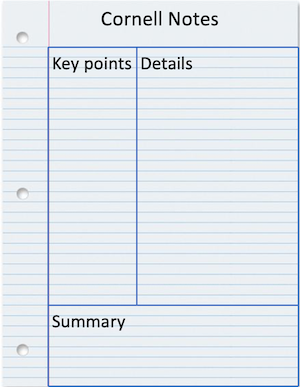Have you ever tried to study from a pile of messy, disorganized notes?
Or even worse, no notes at all?
The Cornell note-taking method is an easy and effective method for taking notes and organizing information while you study. Cornell notes can help you study for any type of quiz or test in 5 simple steps.

To get started, you'll need:
A piece of paper
Your study materials
Pen or pencil
Tip 💡
Want to go digital? Check out the Cornell notes apps and free downloadable templates you can use to organize your notes.
1. Set Up Your Notes

If you're going old school, get out your paper and pencil to set up the Cornell note-taking method:
Draw a vertical line on your paper, about 2.5 inches from the left-hand side, stopping 3 inches from the bottom.
Label the left-hand column Key Points.
Label the right-hand column Details.
Write down the topic at the top of the page.
Draw a horizontal line where your vertical line stops, and label the bottom box Summary.
2. Take Notes While You Study
The larger section on the right-hand side of the page, labeled "Details," is where you'll take notes.

As you listen to lectures or read, write down details, ideas, and facts on the right-hand side of the page.
Leave some space between each idea to make it easier to review and study your notes later.
Use abbreviations, symbols, and bullet points to help you capture information quickly and efficiently.

If you were making a page of Cornell notes for your photosynthesis quiz in biology class, you'd write down key facts about photosynthesis on the right-hand side, and you could use chemical symbols like "H2O" or "O2" to indicate reactants or products.
3. Clarify Key Points
Use the skinny column on the left-hand side of the page to write to keep track of the main ideas:
Write down questions.
Make comments.
Add clarifications about the material.
This will help you engage with the material and identify areas where you need to do more research or study.

 If you were making a page of Cornell notes for your photosynthesis quiz in biology class, you might add some clarifying questions like, "Do plants photosynthesize during the winter?" or, "How many reactants are needed for photosynthesis to occur?"
If you were making a page of Cornell notes for your photosynthesis quiz in biology class, you might add some clarifying questions like, "Do plants photosynthesize during the winter?" or, "How many reactants are needed for photosynthesis to occur?"
Quiz
When studying for his Latin test, Brian notices a pattern in how Roman numerals are used. Where should he write this?
4. Take a Break, then Summarize
After you're done taking notes, it's time for a quick break. Breaks actually help you focus!

When you feel refreshed, it's time to summarize:
Read through your notes carefully.
Summarize the main points and ideas in the bottom section of the page.
This will help you review the material later and understand the key takeaways.
 If you were making a page of Cornell notes for your photosynthesis quiz in biology class, you might add a summary sentence like, "Photosynthesis is the process by which plants make food using sunlight, water, and carbon dioxide."
If you were making a page of Cornell notes for your photosynthesis quiz in biology class, you might add a summary sentence like, "Photosynthesis is the process by which plants make food using sunlight, water, and carbon dioxide."
5. Review Your Notes
Review your notes regularly, and use them to study for exams or quizzes:
Use the Details section to quiz yourself on the material.
Use the Summary section to do a quick, weekly review.
Use the Key Points section to identify areas where you need to focus your attention.

Take Action
Tackle studying for any test using The Cornell note-taking method!

Your feedback matters to us.
This Byte helped me better understand the topic.
